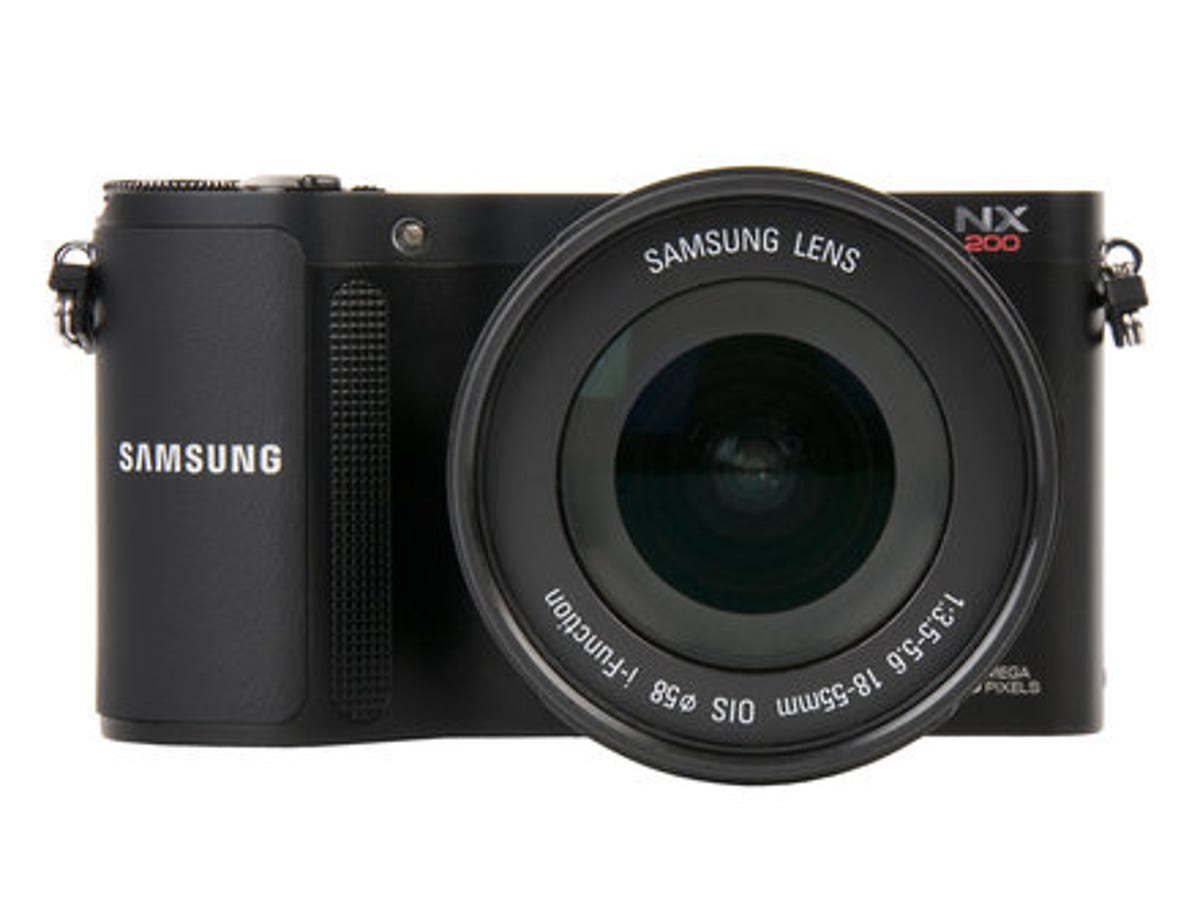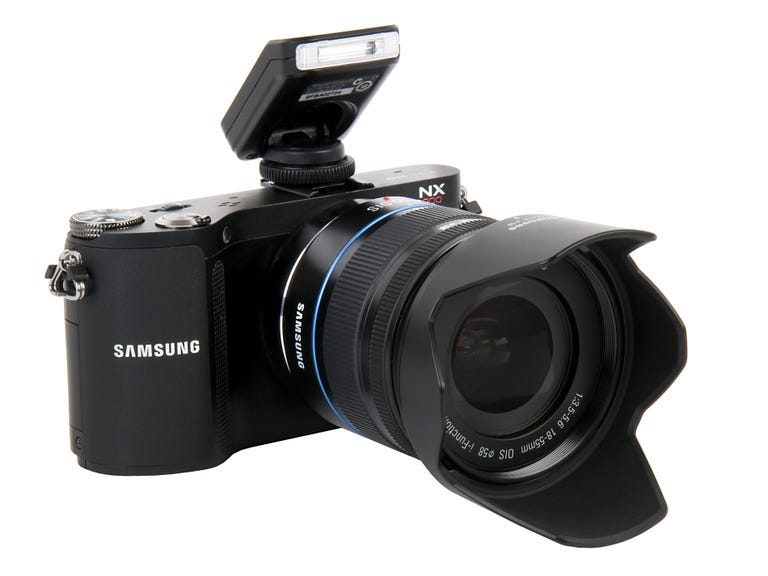 Why You Can Trust CNET
Why You Can Trust CNET Samsung NX200 review: Samsung NX200
The best of both worlds -- a compact body and a hefty set of features -- make the £550 Samsung NX200 a very tempting camera indeed.
Late last year we predicted that 2012 would be dominated by compact snappers with interchangeable lenses. What did we mean by that? Precisely what we see here. Samsung, like Sony, Nikon and Panasonic, has paired a compact camera body with a dSLR-like lens and a large, semi-pro sensor that should, in every respect, deliver the best of all worlds.
The Good
The Bad
The Bottom Line
The Samsung NX200 is available to buy now from £550.
Build and specs
The NX200's native resolution is 20.3 megapixels, which is enormous by any measure, comfortably exceeding most consumer dSLRs. Fortunately, it's accommodated on a chunky APS-C-sized sensor. This very effectively alleviates any problems with noise, which often occur when there are too many megapixels for the sensor to cope with, as seen on lesser cameras.

As the name suggests, it uses Samsung NX-mount lenses. Naturally, this means you have fewer to choose from than if you'd plumped for, say, Nikon or Canon, but all the regular bases are covered. Our review sample arrived with a stabilised 18-55mm f/3.5-5.6 zoom, which is a great all-round unit for everyday use.
The full range includes both prime and zoom lenses, covering off ultra-wide pancake, macro, portrait and 200mm telephoto, among others. Unless you need something particularly obscure or an extremely long zoom, you shouldn't have any problems sating most needs.
There's no optical viewfinder, of course, so all of your framing is done on the rear-mounted 3-inch display. This is bright and fine-grained, so the picture quality is excellent and the menus are logical and well thought out. A choice of four overlay grids help you to perfect your compositions. There's also a live histogram should you want to make sure you're not bleaching out your highlights or losing darker details in the shadows.
The on-body buttons are well placed and your fingers and thumbs fall naturally to them. We particularly appreciated the thumbwheel, which made reviewing shots and navigating menu options fast and efficient. All in all, the NX200's physical build impressed us greatly. It looks good, feels good and is easy to use.
i-Function
The most intriguing control is mounted on the lens, marked iFn. The i-Function feature switches between menu settings on the display, so that you can use the lens' focus ring to set exposure compensation and either shutter speed or aperture, depending on your selected mode. In manual mode, it bundles these together, so you can control both shutter and aperture. This significantly reduces the number of controls you need to master, leaving you free to spend your time thinking about exposure and compensation.
Switch to lens priority mode and you can cut corners further, as this same button lets you use the focus ring to dial in both effects and subject types. The menu here mixes regular options such as landscape, portrait and sunset with effects like half-tone dots and sketch.
Should you choose to use manual focus rather than automatic, it magnifies the centre portion of the image as you adjust to help you see what you're doing. The focus ring is independent of the front screw mount here, so if you've attached a polarising or graduated filter, you won't be set out of alignment.
Shooting features
The NX200's shutter speeds range from 1/4,000 to 30 seconds, with a bulb option exposing the sensor for up to 4 minutes should you need to capture particularly dark scenes.
In less extreme situations you'd rely on ISO and exposure compensation to bump up the levels of captured light. ISO kicks off at 100 and runs through to an impressive 12,800, and you can cap it to avoid it wandering beyond, say, 3,200. Compensation offers -/+3.0EV in 1/3EV steps -- pretty much the norm for a consumer and semi-pro camera.
We particularly liked the ability to set the self-timer to fire the shutter after anything between 2 and 30 seconds. At best, most rivals offer a choice of only two fixed settings -- 2 or 10 seconds -- so this is a versatile alternative for self-portraits that require a greater degree of setting up.
It's quick to find focus, even in tricky scenes dominated by a single or similar colours, such as snow. However, switching between modes immediately after taking a shot -- such as between shutter and aperture priority -- can take a second or two.
We were very impressed by its overall performance in the field, and in particular the abilities of its stabilised lens. The stabilisation was so good that -- without using a tripod -- we could hand-hold the camera for a half-second exposure at full zoom and still achieve a sharp result with smooth moving water.
There was no evidence of any colour fringing, which can sometimes manifest itself along the edge of sharp contrasts such as window frames and the corners of buildings. This indicates that the lens had perfectly aligned the different wavelengths of available light that together make up the visible spectrum. The result was excellent detail and an overall sharpness throughout.
There's plenty of detail to be found in more complex shots too, with hair and fur well-rendered and clear. Sharp edges, such as the outlines of bold characters on signs, are crisp and true to their originals.
This clarity was helped, no doubt, by the APS-C sensor, which is the same size as you'd find in a consumer dSLR and matches that in the Sony NEX-5N, which we reviewed in October 2011. That gives Samsung room to space out the individual photosites so that they don't quickly overload and cause interference within the image.
Indeed, the NX200 and NEX-5N share more than just a sensor and two very similar names. Physically, they're highly reminiscent of one another, with a slim metal body and a comfortable hand grip around the battery and media card compartment. The flash units are both add-ons, and they each boast a sweep panorama mode that stitches together a wide arc as you move the camera past it (although we found the NX200 had trouble detecting movement in low light and so would sometimes cancel the operation).
The key difference between them is the Sony's touchscreen display. The Samsung lacks this. Although it's not something we missed -- particularly when we could rely on the i-Function lens system when tweaking many of our settings -- the fact that the cameras are closely priced makes the Sony look a slightly better deal. Admittedly, it sports only 16 megapixels to the Samsung's 20, but so long as you're wise enough not to fall for the megapixel myth, you wont hold this against it.
The NX200 did a great job of capturing our still-life set-up, in which we gathered a collection of everyday objects with differing colours and surface textures (above). We set the aperture to f/16, to keep the scene sharp from front to back, and shot it three times -- with only the room's ambient light, using the screw-on flash and under studio lighting.
In each instance, the result was crisp and full of detail, despite the heightened sensitivity (ISO 800), which introduced just the slightest hint of noise. Fabric, such as the runner beneath the objects and the triangular doorstop at the back of the scene, were highly detailed. Solid surfaces like the Morph character and plant pot demonstrated smooth, even and well-rendered transitions in their illumination.
As with most cameras, the NX200 achieved its best results under studio lighting conditions, but it also impressed when using only the available ambient light. We were slightly disappointed by the result obtained when using the flash, as some of the colours were a little washed out.
Video performance
We have no complaints where the NX200's video performance is concerned. Images were sharp and well exposed, even when it was faced with the tricky task of filming largely flat scenes dominated by fallen snow.
The soundtrack was extremely clear and well recorded, but iMovie users should beware that it wasn't imported along with the footage in our tests, leaving us with a silent clip bin. Converting it before import fixed this and didn't take long, but it was an unwelcome quirk nonetheless.
Conclusion
We were greatly impressed by the NX200. It feels sturdy and takes a great set of shots. The menus are simple enough for a novice to navigate without constant reference to the manual. The layout of its on-chassis controls is logical, and everything's easy to use, even when you're wearing gloves, as we were during our outdoor tests.
Its trump card though is the i-Function lens system, which is undoubtedly our favourite feature. We'd love to see it emulated by Samsung's rivals.
The NX200 would be a great choice for the more ambitious hobby photographer and is perfectly suited to keen travellers. Its compact body packs in everything you could want from a low-end dSLR, without either the bulk or the weight you might expect.


